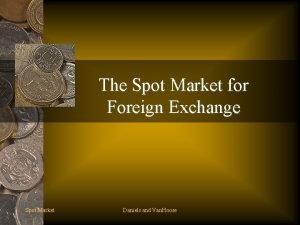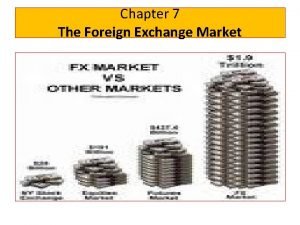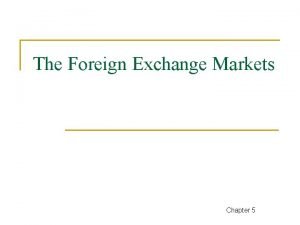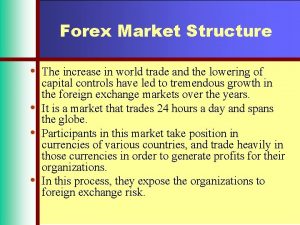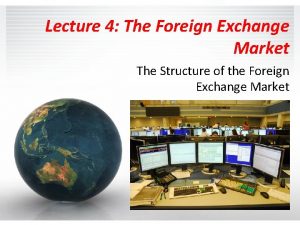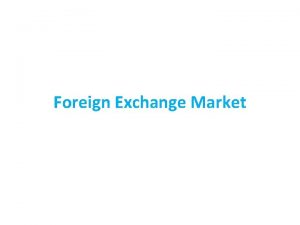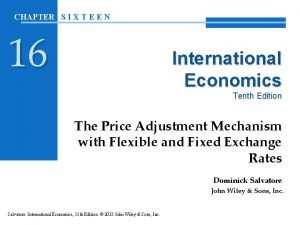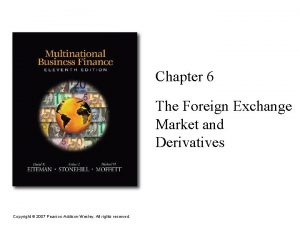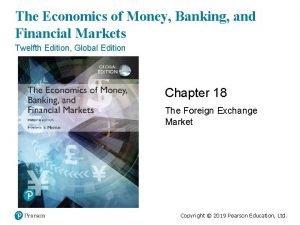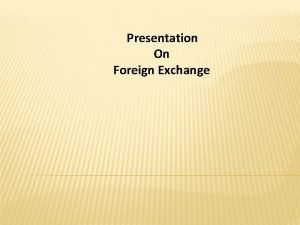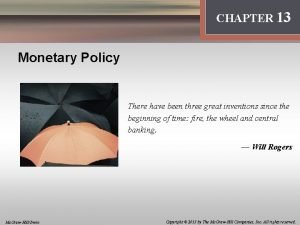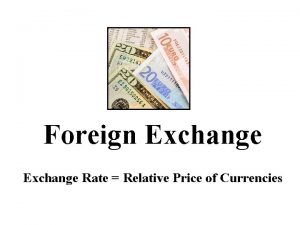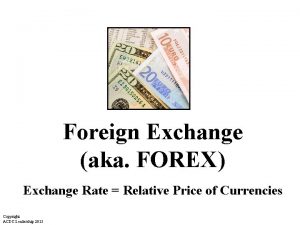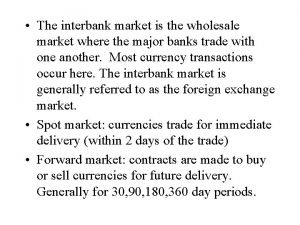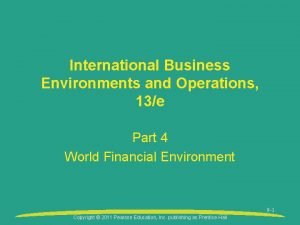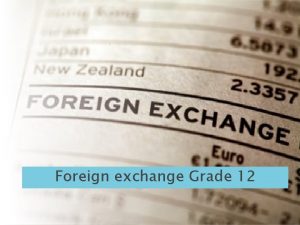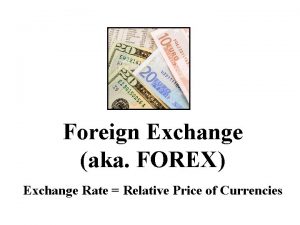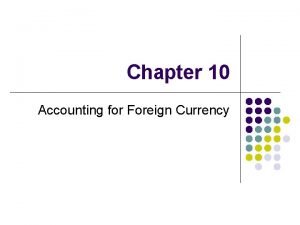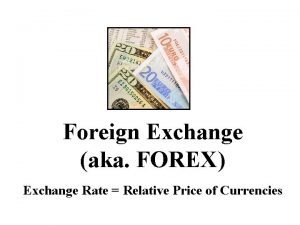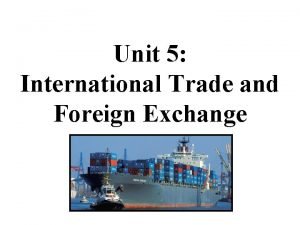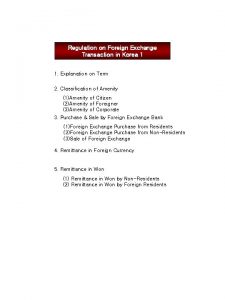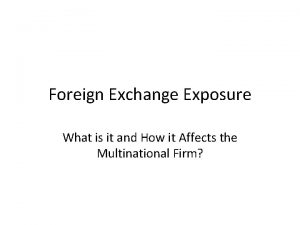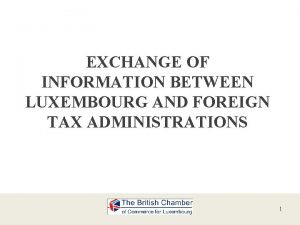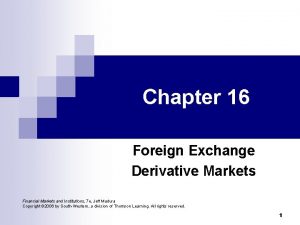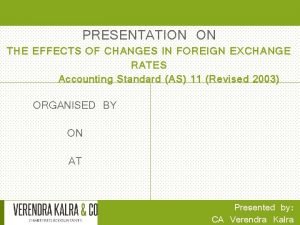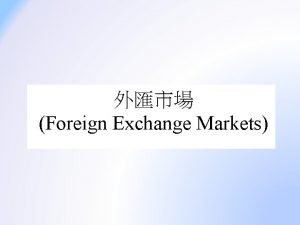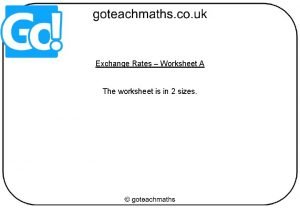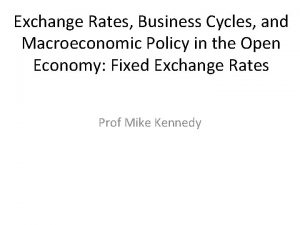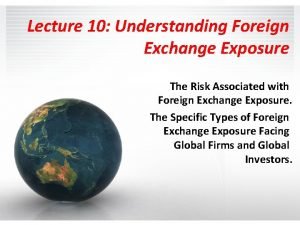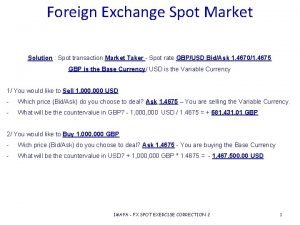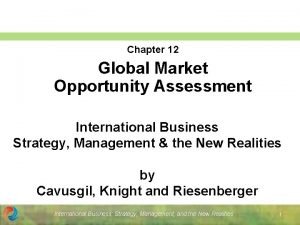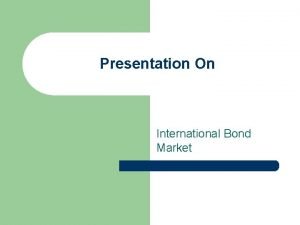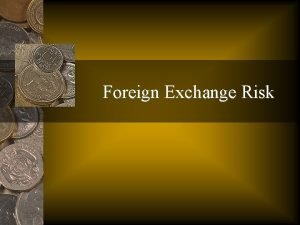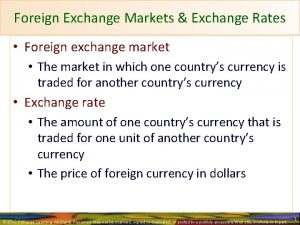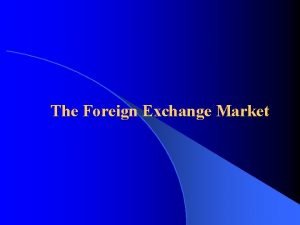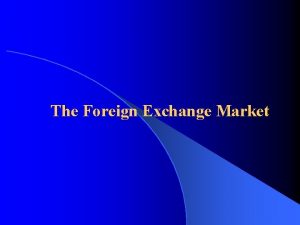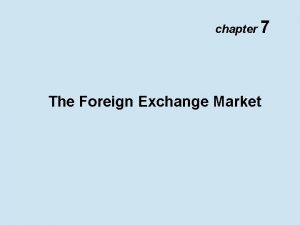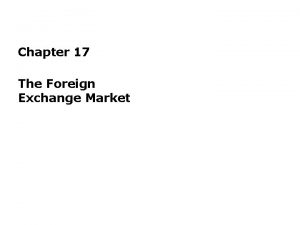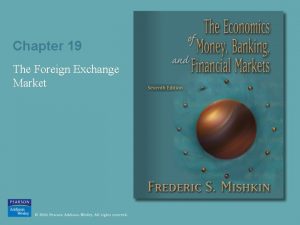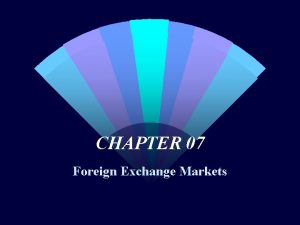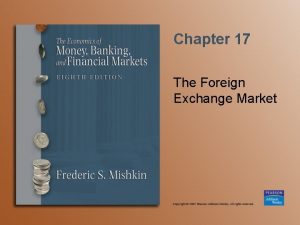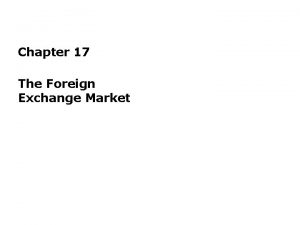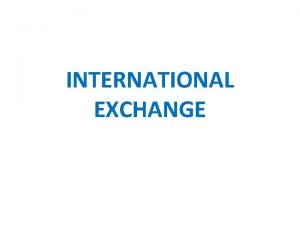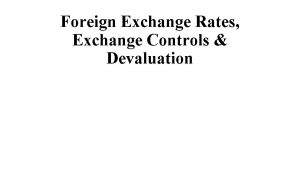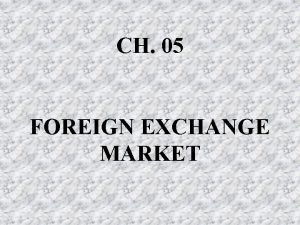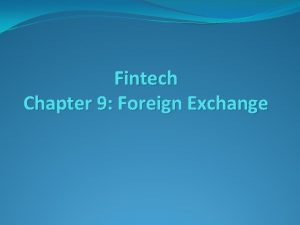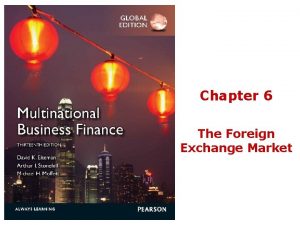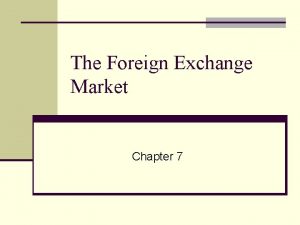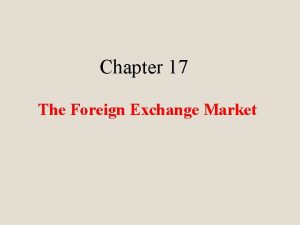Chapter 10 The Foreign Exchange Market Foreign Exchange











































- Slides: 43

Chapter 10 The Foreign Exchange Market

Foreign Exchange Ø The foreign exchange market – Is the market where one buys or sells the currency of country A with the currency of country B Ø A currency exchange rate – Is simply the ratio of a unit of currency of country A to a unit of the currency of country B at the time of the buy or sell transaction

An exchange rate is the rate at which one currency can be exchanged for another. In other words, it is the value of another country's currency compared to that of your own. If you are traveling to another country, you need to "buy" the local currency. Just like the price of any asset, the exchange rate is the price at which you can buy that currency. If you are traveling to Egypt, for example, and the exchange rate for U. S. dollars is 1: 5. 5 Egyptian pounds, this means that for every U. S. dollar, you can buy five and a half Egyptian pounds. Theoretically, identical assets should sell at the same price in different countries, because the exchange rate must maintain the inherent value of one currency against the other.


The Foreign Exchange Market Ø Currency conversion in the foreign exchange market – Is necessary to complete private and commercial transactions across borders – A tourist needs to pay expenses on the road in local currency – A firm • Buys/sells goods and services in the other country’s local currency • Uses the foreign exchange market to invest excess funds Ø Is used to speculate on currency movements

The Foreign Exchange Market Ø Minimizes foreign exchange risk (unpredictable rate swings) Ø To do so there are different ways to trade currencies – Spot exchange rates: the day’s rate offered by a dealer/bank – Forward exchange rates: • Agreed in advance rates to buy/sell a currency on a future date • Usually quoted 30, 90, 120 days in advance Ø The market is “open” 24 hours… Ø Arbitrage is the process of buying low and selling high … given slightly different exchange rate quotes in one location vs another (e. g. , London vs Tokyo)

Prices and Exchange Rates Ø The law of one price: – Identical products sold in different countries must sell for one price if their price is expressed in one currency – Assumptions: • Competitive markets • No transportation costs; no trade barriers Ø Purchasing Power Parity (PPP): – If the law of one price holds for all goods / services, the PPP exchange rate is found by comparing prices of identical products in different countries

The law of one price says that identical goods should sell for the same price in two separate markets when there are no transportation costs and no differential taxes applied in the two markets. Consider the following information about movie video tapes sold in the US and Mexican markets. Price of videos in US market : $20 Price of videos in Mexican market: p 150 Spot exchange rate (Ep/$): 10 p/$ The dollar price of videos sold in Mexico can be calculated by dividing the video price in pesos by the spot exchange rate as shown,

To see why the peso price is divided by the exchange rate (rather than multiplied) notice the conversion of units shown in the brackets. If the law of one price held, then the dollar price in Mexico should match the price in the US. Since the dollar price of the video is less than the dollar price in the US, the law of one price does not hold in this circumstance.

The Law of One Price We can mathematically state the law of one price as follows, for the case of any good g sold in two locations: expresses the rate at which goods can be exchanged: it tells us how many units of the U. S. good are needed to purchase one unit of the same good in Europe. expresses the rate at which currencies can be exchanged ($/€).

The Law of One Price We can rearrange the equation for price equality to show that the exchange rate must equal the ratio of the goods’ prices expressed in the two currencies:

Purchasing Power Parity The principle of purchasing power parity (PPP) is the macroeconomic counterpart to the microeconomic law of one price (LOOP). To express PPP algebraically, we can compute the relative price of the two baskets of goods in each location: There is no arbitrage when the basket is the same price in both locations q. US/EUR = 1. PPP holds when price levels in two countries are equal when expressed in a common currency. This statement about equality of price levels is also called absolute PPP.

The Relationship Between PPP and the Law of One Price – The law of one price applies to individual commodities, while PPP applies to the general price level. – If the law of one price holds true for every commodity, PPP must hold automatically for the same reference baskets across countries if each commodity is traded. Slide 15 -13 Copyright © 2003 Pearson Education, Inc.

The Real Exchange Rate The relative price of the baskets is one of the most important variables in international macroeconomics, and it has a special name: it is known as the real exchange rate. The U. S. real exchange rate q. US/EUR = E$/€ PEUR/PUS tells us how many U. S. baskets are needed to purchase one European basket; it is the price of the European basket in terms of the U. S. basket. The exchange rate for currencies is a nominal concept. The real exchange rate is a real concept; it says how many U. S. baskets can be exchanged for one European basket.

Money Supply and Currency Value ØInflation occurs when the quantity of money in circulation rises faster than the stock of goods and services ØMoney supply growth related to currency value ØRelative inflation rates and trends can predict relative exchange rate movements ØWhen changes in relative prices in two countries change their currencies’ exchange rate, then the currency of the country with the highest inflation should decline in value

Interest Rates and Exchange Rates Ø Interest rates reflect expectations of inflation rates; – high interest rates reflect high inflation expectation – Fisher Effect: i = r + I • i: “nominal” interest rate in a country • r: “real” interest rate • I: inflation over the period the funds are to be lent – International Fisher Effect: (S 1 -S 2)/S 2 X 100 = i$ - i¥ • For any two countries the spot exchange rate should change in an equal amount but in the opposite direction to the difference in nominal interest rates between the two countries • S 1: spot rate at time 1, S 2 : spot rate at time 1; i$, i¥: nominal interest rates in the US and Japan

Convertibility Ø Currency convertibility and government policy – Freely convertible: residents/non-residents allowed to purchase unlimited amounts of a foreign currency with the local currency – Not freely convertible: residents/non-residents not allowed to purchase unlimited amounts of a foreign currency with the local currency

Fixed Exchange Rate Regime A fixed exchange rate, sometimes called a pegged exchange rate, is a type of exchange rate regime where a currency's value is fixed against either the value of another single currency, to a basket of other currencies, or to another measure of value, such as gold. A fixed, or pegged, rate is a rate the government (central bank) sets and maintains as the official exchange rate. A set price will be determined against a major world currency (usually the U. S. dollar, but also other major currencies such as the euro, the yen or a basket of currencies). In order to maintain the local exchange rate, the central bank buys and sells its own currency on the foreign exchange market in return for the currency to which it is pegged.

There are benefits and risks to using a fixed exchange rate. A fixed exchange rate is typically used in order to stabilize the value of a currency by directly fixing its value in a predetermined ratio to a different, more stable or more internationally prevalent currency (or currencies), to which the value is pegged. In doing so, the exchange rate between the currency and its peg does not change based on market conditions, the way floating currencies will do. This makes trade and investments between the two currency areas easier and more predictable, and is especially useful for small economies, economies which borrow primarily in foreign currency, and in which external trade forms a large part of their GDP.

In a fixed exchange-rate system, a country’s central bank typically uses an open market mechanism and is committed at all times to buy and/or sell its currency at a fixed price in order to maintain its pegged ratio and, hence, the stable value of its currency in relation to the reference to which it is pegged. The central bank provides the assets and/or the foreign currency or currencies which are needed in order to finance any payments imbalances. System in which the value of a country's currency, in relation to the value of other currencies, is maintained at a fixed conversion rate through government intervention. Also called pegged exchange rate. Opposite of floating exchange rate.

In the 21 st century, the currencies associated with large economies typically do not fix or peg exchange rates to other currencies. The last large economy to use a fixed exchange rate system was the People's Republic of China which, in July 2005, adopted a slightly more flexible exchange rate system called a managed exchange rate. The European Exchange Rate Mechanism is also used on a temporary basis to establish a final conversion rate against the Euro (€) from the local currencies of countries joining the Eurozone.

Types of fixed exchange rate systems - The gold standard Under the gold standard, a country’s government declares that it will exchange its currency for a certain weight in gold. In a pure gold standard, a country’s government declares that it will freely exchange currency for actual gold at the designated exchange rate. This "rule of exchange” allows anyone to go the central bank and exchange coins or currency for pure gold or vice versa. The gold standard works on the assumption that there are no restrictions on capital movements or export of gold by private citizens across countries.

Because the central bank must always be prepared to give out gold in exchange for coin and currency upon demand, it must maintain gold reserves. Thus, this system ensures that the exchange rate between currencies remains fixed. For example, under this standard, a £ 1 gold coin in the United Kingdom contained 113. 0016 grains of pure gold, while a $1 gold coin in the United States contained 23. 22 grains. The mint parity or the exchange rate was thus: R = $/£ = 113. 0016/23. 22 = 4. 87. The main argument in favor of the gold standard is that it ties the world price level to the world supply of gold, thus preventing inflation unless there is a gold discovery (a gold rush, for example).

- Price specie flow mechanism The automatic adjustment mechanism under the gold standard is the price specie flow mechanism, which operates so as to correct any balance of payments disequilibrium and adjust to shocks or changes. This mechanism was originally introduced by Richard Cantillon and later discussed by David Hume in 1752 to refute the mercantilist doctrines and emphasize that nations could not continuously accumulate gold by exporting more than their imports.

The assumptions of this mechanism are: - Prices are flexible All transactions take place in gold There is a fixed supply of gold in the world Gold coins are minted at a fixed parity in each country There are no banks and no capital flows

Adjustment under a gold standard involves the flow of gold between countries resulting in equalization of prices satisfying purchasing power parity, and/or equalization of rates of return on assets satisfying interest rate parity at the current fixed exchange rate. Under the gold standard, each country's money supply consisted of either gold or paper currency backed by gold. Money supply would hence fall in the deficit nation and rise in the surplus nation. Consequently, internal prices would fall in the deficit nation and rise in the surplus nation, making the exports of the deficit nation more competitive than those of the surplus nations. The deficit nation's exports would be encouraged and the imports would be discouraged till the deficit in the balance of payments was eliminated

In brief: Deficit nation: Lower money supply → Lower internal prices → More exports, less imports → Elimination of deficit Surplus nation: Higher money supply → Higher internal prices → Less exports, more imports → Elimination of surplus

Reserve currency standard In a reserve currency system, the currency of another country performs the functions that gold has in a gold standard. A country fixes its own currency value to a unit of another country’s currency, generally a currency that is prominently used in international transactions or is the currency of a major trading partner. For example, suppose India decided to fix its currency to the dollar at the exchange rate E₹/$ = 45. 0. To maintain this fixed exchange rate, the Reserve Bank of India would need to hold dollars on reserve and stand ready to exchange rupees for dollars (or dollars for rupees) on demand at the specified exchange rate. In the gold standard the central bank held gold to exchange for its own currency, with a reserve currency standard it must hold a stock of the reserve currency.

Gold exchange standard The fixed exchange rate system set up after World War II was a goldexchange standard, as was the system that prevailed between 1920 and the early 1930 s. A gold exchange standard is a mixture of a reserve currency standard and a gold standard. Its characteristics are as follows: - All non-reserve countries agree to fix their exchange rates to the chosen reserve at some announced rate and hold a stock of reserve currency assets. - The reserve currency country fixes its currency value to a fixed weight in gold and agrees to exchange on demand its own currency for gold with other central banks within the system, upon demand. - Unlike the gold standard, the central bank of the reserve country does not exchange gold for currency with the general public, only with other central banks.

Floating Exchange Rate Regime A floating exchange rate or fluctuating exchange rate is a type of exchange-rate regime in which a currency's value is allowed to fluctuate in response to foreign-exchange market mechanisms. A currency that uses a floating exchange rate is known as a floating currency. A floating currency is contrasted with a fixed currency whose value is tied to that of another currency, gold or to a currency basket.

In the modern world, most of the world's currencies are floating; such currencies include the most widely traded currencies: the United States dollar, the euro, the Norwegian krone, the Japanese yen, the British pound, and the Australian dollar. However, central banks often participate in the markets to attempt to influence the value of floating exchange rates. The Canadian dollar most closely resembles a "pure" floating currency, because the Canadian central bank has not interfered with its price since it officially stopped doing so in 1998. The US dollar runs a close second, with very little change in its foreign reserves; in contrast, Japan and the UK intervene to a greater extent.

System in which a currency's value is determined solely by the interplay of the market forces of demand supply, instead of by government intervention. However, all central banks do try to defend these rates within a certain range by buying or selling their country's currency as the situation warrants.

Unlike the fixed rate, a floating exchange rate is determined by the private market through supply and demand. A floating rate is often termed "self-correcting, " as any differences in supply and demand will automatically be corrected in the market. Look at this simplified model: if demand for a currency is low, its value will decrease, thus making imported goods more expensive and stimulating demand for local goods and services. This in turn will generate more jobs, causing an auto-correction in the market. A floating exchange rate is constantly changing. In a floating regime, the central bank may also intervene when it is necessary to ensure stability and to avoid inflation. However, it is less often that the central bank of a floating regime will interfere.

What is the difference between a fixed and a floating exchange rate? A fixed exchange rate denotes a nominal exchange rate that is set firmly by the monetary authority with respect to a foreign currency or a basket of foreign currencies. By contrast, a floating exchange rate is determined in foreign exchange markets depending on demand supply, and it generally fluctuates constantly.

A fixed exchange rate regime reduces the transaction costs implied by exchange rate uncertainty, which might discourage international trade and investment, and provides a credible anchor for low-inflationary monetary policy. On the other hand, autonomous monetary policy is lost in this regime, since the central bank must keep intervening in the foreign exchange market to maintain the exchange rate at the officially set level.

Autonomous monetary policy is thus a big advantage of a floating exchange rate. If the domestic economy slips into recession, it is autonomous monetary policy that enables the central bank to boost demand, thus 'smoothing" the business cycle, i. e. reducing the impact of economic shocks on domestic output and employment. Both types of exchange rate regime have their pros and cons, and the choice of the right regime may differ for different countries depending on their particular conditions. In practice there is a range of exchange rate regimes lying between these two extreme variants, thus providing a certain compromise between stability and flexibility.

Chronology of Exchange Rate Regimes in Turkey: 1880– 2000 1880– 1914 Specie: Gold Standard 1919– 1945 Gold Exchange Standard 1946– 1971 Bretton Woods adjustable peg 1973– 2000 Free float, managed float, adjustable pegs

Period before 1980: Fixed Exchange Rate Regime Period between 1980 -1996 � Crawling Peg Exchange Rate Regime (1980 – 1989) • Liberalization of the foreign exchange market in 1984 • Currency substitution started in 1985 • Liberalization of capital movements in 1989 with 32 numbered decree �A flexible Exchange Rate Regime (1989 – 1993) �Adoption of Crawling Band Regime (1994 – 1996) • Economic Crisis in April 1994 • Stabilization Program (April 5, 1994)

Period between 1996 -2000 Rate of increase in foreign exchange basket was targeted in order to minimize the volatility of the real exchange rate for the years between 1996 -1999. �Currency-Peg Regime was determined as the nominal anchor in the stabilization program in 2000. • Stand-by Agreement with IMF in 2000 • Liquidity Crisis in November 2000 • New Agreement with IMF on December 18, 2000 • No change on the exchange rate policy.

Period Starting from 2001 �Floating exchange rate regime • Economic crisis in February 2001. • New Stand-by Agreement with IMF on May 28, 2001 • New Economic Stabilization Program initiated in 2002 • Implicit Inflation Targeting between 2002 and 2005 • Limited Central Bank intervention in the foreign exchange market - to prevent excessive volatility • Formal Inflation Targeting adopted in 2006 • Adoption of new regulations to ensure the efficiency in the foreign exchange market and to reinforce foreign exchange liquidity in the banking system in 2008 • Expansionary monetary policy was abandoned with announcement of the Monetary Policy Exit Strategy on April 14, 2010. • In the fourth quarter of 2010, inflation targeting was augmented with an additional financial stability orientation.

Appreciation and Depreciation Appreciation is an increase in a property’s value caused by factors like inflation, increasing demand, and improvements to the property. Depreciation is a decrease in the value of a property caused by lower demand, deflation in the economy, deterioration, or the influences of other undesirable factors.

Depreciation – fall in value of exchange rate – exchange rate becomes weaker (devaluation) Appreciation – increase in value of exchange rate – exchange rate becomes stronger. Example of Pound Sterling depreciating against the Dollar. £ 1 used to equal $2. Now £ 1 is only equal to $1. 75 Example of Pound Sterling appreciating against the Dollar. £ 1 used to equal $2. Now £ 1 is equal to $2. 75

A depreciation in exchange rate makes exports more competitive and imports more expensive. An appreciation in the exchange rate will tend to reduce aggregate demand (assuming demand is relatively elastic). Because exports will fall and imports increase. An appreciation is likely to reduce inflation because: - Import prices are cheaper - Fall in aggregate Demand - Firms have more incentives to cut costs.
 Spot market in foreign exchange market
Spot market in foreign exchange market Functions of foreign exchange market
Functions of foreign exchange market Objectives of foreign exchange
Objectives of foreign exchange Market structure definition forex
Market structure definition forex Structure of foreign exchange market
Structure of foreign exchange market Foreign exchange market features
Foreign exchange market features Stability of foreign exchange market
Stability of foreign exchange market Foreign exchange market example
Foreign exchange market example Foreign exchange market graph
Foreign exchange market graph Exchange rate presentation
Exchange rate presentation Foreign exchange market graph
Foreign exchange market graph Exchange rate graph
Exchange rate graph Foreign exchange market
Foreign exchange market Forex shifters
Forex shifters Interbank wholesale
Interbank wholesale Market leader market challenger market follower
Market leader market challenger market follower Market segmentation and positioning
Market segmentation and positioning Too foreign for here too foreign for home
Too foreign for here too foreign for home Forex trading process
Forex trading process Bbr and bsr meaning
Bbr and bsr meaning Foreign exchange shifters
Foreign exchange shifters Forex accounting
Forex accounting Xlri jamshedpur student exchange program
Xlri jamshedpur student exchange program 4 shifters of foreign exchange
4 shifters of foreign exchange International trade and foreign exchange
International trade and foreign exchange Foreign exchange transaction regulation korea
Foreign exchange transaction regulation korea Markets
Markets Foreign exchange exposures
Foreign exchange exposures Christophe joosen
Christophe joosen Foreign exchange means
Foreign exchange means Foreign exchange derivative
Foreign exchange derivative Integral and non integral foreign operations
Integral and non integral foreign operations Exchange rate meaning in maths literacy
Exchange rate meaning in maths literacy Diagram foreign exchange management act
Diagram foreign exchange management act Foreign exchange and international financial markets
Foreign exchange and international financial markets Wise foundation
Wise foundation Synthetic forward rate agreement
Synthetic forward rate agreement Exchange rates worksheet
Exchange rates worksheet Exchange rate graph economics
Exchange rate graph economics Transaction exposure example
Transaction exposure example Spot transaction in foreign exchange
Spot transaction in foreign exchange Foreign market opportunity analysis
Foreign market opportunity analysis Eurobond market characteristics
Eurobond market characteristics Addison currency exchange
Addison currency exchange
